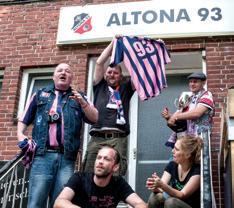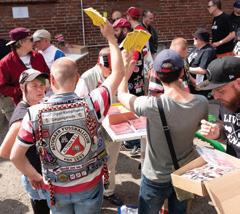
5 minute read
Sustainability Jargon Buster
Climate and football
What is Climate Change?
Advertisement
We have all heard climate change discussed for a long time in conversation and in the media. Climate change is defined as: a longterm shift in global weather patterns or average temperatures. A rise in temperature can lead to extreme weather such as storms, floods, droughts and heatwaves.
Climate ‘cha nge’, ‘breakdown’ or ‘emergency’?
Climate breakdown is a new definition for the effects on the planet as a result of humancaused emissions.
There is much discussion over the phrasing used when talking about the environment. Is it enough to say ‘Climate Change?’ Some feel that this definition fails to communicate the urgency or complexity of this man-made situation. Therefore, ‘Climate Breakdown’ has become a phrase used by the scientific community as an accurate way of defining what is an intricate, decades-long breakdown. Popular with activists and many serious people is “Climate Emergency’.
What is a carbon footprint ?
The amount of carbon dioxide or CO2e released into the atmosphere due to the actions of an individual, activity, business or organisation over a given time period. The concept of a personal carbon footprint was propagated by a 2005 BP marketing campaign conceived by ad agency Ogilvy & Mather. The campaign was intended to divert attention and responsibility away from the fossil fuel industry onto individual consumers. It worked.
What does GHG stand for?
GHG is an abbreviation for greenhouse gasses. GHGs trap heat or longwave radiation in the atmosphere, which can then lead to the rise in temperatures that constitute climate change. The primary greenhouse gas is Carbon, which is often discussed in relation to climate change as it is the main gas over which we humans have control.
Sustainable
If a product or activity is sustainable then it means that it can be maintained over time because the resources that it uses are being replaced at the same rate that they are being used, rather than being depleted. Bear this definition in mind when companies hawk their products, whether they are clothes or dishwashing tablets- are they actually sustainable, or are the companies just relying on the consumer to not question what they are telling them?
Sustainable business
A business that has no net impact upon the natural world because its activities and products have been designed to be have minimal impact (through design or reductions), use resources from sustainable sources, and any remaining impact is accounted for and offset. Again, it pays to have a critical eye when companies claim they have ‘sustainable business practices’ - many people think that any kind of profit-hoarding business cannot be truly sustainable.
Greenwashing
When a company misleads consumers about the environmental impacts of their products or services for marketing purposes. This can range from misleading consumers through vague or unsubstantiated claims, the use of brand names, identities and colour schemes that imply “green” credentials, through to the subversion or selective sharing of scientific reports and celebrating environmental or climate ‘acheivements’ in such a way as to create a false, positive narrative about a business which is actually making climate change worse. The older sibling of sportswashing.
Climate action
As defined by the UN’s thirteenth Sustainable Development Goal, climate action is: “Take urgent action to combat climate change and its impacts”. SDG 13 has targets, which are to be achieved by 2030. Climate action isn’t restricted to protest, but to any action with the purpose of combating, mitigating or reversing the drivers of climate change and its impacts.
Single-use
An item that is designed to only be used once before being discarded, or that is usually only used once before being discarded because of consumer habits. A good example of a single-use product the pint glasses we serve drinks in here at the Hamlet – we’re working on that.
Circular economy
Most economies extract and then use a resource, in a process described as ‘linear’ - a resource, is taken, used and then discarded. A circular economy is a system that proposes a ‘closed loop’. This is when the resources are inputted but then retain their value so that a product can be designed, produced, distributed, used and then reused. The idea is find a life after use for products, for example
There is controversy over how corporations use the idea of the circular economy. It’s not unusual that firms suggest publically that the circular economy will fix their business models, relying on solutions which in many cases are unproven at scale.
Carbon offsetting
When a business says “for every X sold we plant a tree”. Souds nice right? However, this is often performative environmentalism, there’s not enough land to plant the volume of trees required to offset the emissions of all the firms claiming to be doing so.
Offsetting projects come with som,e Serious issues about the repurposing of indigenous and existing agricultural lands. In many countries where offsetting planting projects are seen as viable land ownership is often contested with tenure, and human rights, being disregardfed to facilitate these new projects.
On a warming planet, as forest fires become more regular it does seem optimistic to assume that planting more trees is a genuine, long-term solution for carbon storage.
Esg
Environmental, Social and Governance (ESG) criteria are a set of standards that investors use to assess a company based on their environmental and social impacts and their corporate governance. They use this information to determine if the company constitutes an ethical investment. This practice is also known as socially responsible investing, impact investing, or sustainable investing.
Fair Trade
A trading partnership that seeks greater equity in international trade, ensuring that producers in countries of origin (often smallscale farmers) are paid fairly and treated with dignity, respect, equality and fairness. The fair trade label is the mark of a global organisation that is co-owned by more than 1.8 million farmers and workers, and its appearance on products helps consumers to make better purchasing decisions.
Net Zero
Net zero emissions will be reached when the amount of greenhouse gas emissions produced by an entity (be that an individual, a business, an organisation or a country) is equal to the amount removed from the atmosphere. There are two ways to do this, which run concurrently: reducing existing emissions and actively removing greenhouse gases. If we were able to eradicate all emissions completely, gross zero emissions would be achieved. But that is an unrealistic target for most, so net zero is used in recognition that some emissions are inevitable but must be accounted for and offset.
Net zero assumes that reduction and offsetting will both work simultaneously when being delivered by businesses and organisations who have missed most of the targets set for themselves in previous environmental projects
Many firms have built offsetting into their net zero targets, assuming that net zero is acheivable. Firms may be doing this honestly, or it may be a ruse to allow them to operate BAU.
Business as Usual (BAU)
When corporations, organisations and individuals work in such a way as to seemingly ignore climate change, as if it will go away, or it’s someone else’s problem to deal with.
Organic
Defined as “relating to or derived from living matter” or, in the case of food and farming, produced without the use of synthetic fertilisers, pesticides and herbicides.
Scope 1 emissions
Direct emissions from owned or controlled sources within the business, such as any vehicles owned by the company, business travel, or central heating.
Scope 2 emissions
This is the footprint of a business or household’s electricity and gas bills –emissions created indirectly or off-site from the generation of purchased energy
Scope 3 emissions
Seen locally this is about things like employee commuting. But there are also the hard-to-see emissions, mainly because they often occur far away from where products and services are used or delivered. Supply chains for agriculture, food packaging and fashion have huge emissions.












